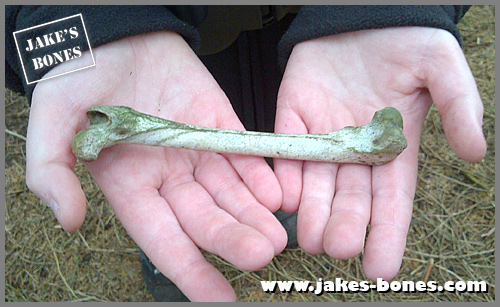I currently get about 750 emails a year and I try to respond to every single one of them. A lot of the emails I get are people asking "I've found a bone, but what is it ?", asking me to identify bones that they have found but they can't work out what they are from. Sometimes the bones are actually quite simple, but you have to look at them in a certain way to work out what they are.
Over the summer I've been photographing common bones that I find on walks, the sort of thing that I don't look at for long any more because I have others at home, or because I find so many of them. I hope this helps others trying to identify bones they have found !
Long thick bones
Medium-sized skulls with big eye sockets.
A big u-shaped bone with two holes.
This is a pelvis. It's usually found in two halves but older animals have them joined together. (Baby animals have them in four or six parts, like this baby deer). The pelvis joins the femur to the spine. The ball of the femur goes in the hollow. My rearticulated fox skeleton shows it better.
From the size, this looks like a fox.
Pointy skull with low down eye sockets.
Bones shaped like the space shuttle
It's a vertebrae from the lower part of the spine. This is probably from a sheep because it looks too thick to be a roe deer. On this one the outer layer of bone has worn away showing the honeycomb inside.
Small bone shaped like a forearm and clenched fist
A thin Y or U shaped bone
Very fine, fragile folded bone.
It is from this baby roe deer skull. Skulls are made up of different parts, called plates. In baby animals these plates aren't fused together yet, which is why you can see the two halves of the braincase.
A small ball of fur
A long bone with a spike
The spike makes this bone confusing, but it is a leg bone called a tarsometatarsus from a pheasant. The spike is called a spur. You can sometimes tell the age of the bird from the size of the spike.
A hollow ball with spikes on the front
This is confusing because it's broken. It's obviously a skull, but the front beak has broken off at the 'hinge' on the nose. This is from a pheasant as well.
If you find a bone but can't identify it, email me at jakesbones@gmail.com. Things that help are photos which show scale and it from different angles, and where you found it (a lot of people forget to say the country !) I currently get about 750 emails a year and try to reply to every one. You might also want to see if you can recognise the shape here (if it's a mammal) or here (if it's a bird)
Enjoy this post ? Share it !




































14 comments :
Great post Jake, thanks!
I'm so pleased to have been told about your blog. And I like this page - a very useful resource for beginners like myself. Thank you and look forward to learning more.
I have an armadillo pelvis that looks weird. Took me a while to figure out exactly what it was. Would you like a picture of it to add to here in case someone finds an armadillo? I can also put a bit of armadillo plating in the picture... They aren't from the same one, but I at least think they were both adult. The pelvis is kind of a strange color because it was extremely fragile (I think from being bleached in the Texas sun for too long, could have been years) so I dipped it in epoxy to preserve it.
I have one of those skulls. I thought it belonged to a squirrel but now I can see it's pheasant. Curiously, my pheasant skull is broken in exactly the same shape.
A lot of bird skulls break here, it's the 'hinge' where the beak can flex, so it's a weak spot.
Hi, I was wondering what the green staining of the bone is?
Anyone have an idea what this belongs too I originally thought it was a tooth due to the shape but realise it's most likely a bone I found it on the beach x
Some kind of algae growth.
No idea...you didn't attach a pic !
Can anyone help me identify this please
Hard without a picture !
Sorry
Side view and under
Another pic
Post a Comment